Of all the Hawaiian Islands, because it is the youngest, the Big Island has the fewest and smallest beaches…this leads to crowding during the height of tourist season at some beaches. Because Hawaii is still rural, there are still some wilderness (hike-to-only) beaches; a few of them are among the best on the island.
Many wild beaches may be camped upon but you must apply for a permit from the appropriate land owner or agency. Overnight camping on Hawaii beaches in general is simplified because of the mild climate--preferring a more intimate camping experience that is facilitated by Hawaii's generally warm, calm weather, usually I just take a few quarts of water, a couple sandwiches, my camera, dry clothes for post-snorkeling comfort, a fleece blanket (a dry beach towel will suffice--generally there is no need for a sleeping bag) and rice mat to sleep on and a small tarp on the off-chance it rains. You may wish to bring a few extra quarts of water to rinse the salt off after bathing--many people find it difficult to sleep with salty skin.
However, in truth, you are usually so close to the parking lot, and most trails are short and easy (exceptions: Green Sand Beach and Waipi'o), that you can bring just about anything you can carry in--just be sure to take back out everything you brought. On these delicate and beautiful beaches it is imperative to practice good backcountry skills and leave no trace. Fires are illegal on these beaches as is hacking down the few trees and bushes to make shelter; even if it wasn't illegal, it would be immoral in the extreme to wreak such havoc and destruction on the last of Polynesia's superb, wilderness beaches.
There are wild goats that inhabit the areas around backcountry beaches and use the local springs for watering. Usually they evince little curiosity about, or fear of, visiting humans. However, they are wild and they are big and they are ornery--you are best to keep your distance, do not harass or try to feed them. This includes your garbage management, as garbage will attract them, too. Mongooses can also be a problem, raiding your garbage and food supply. Like all desert animals, the goats and mongooses are hungry for salt and have been known to steal and eat sweaty hiking shoes, t-shirts and socks. Keep a clean campsite, keep your garbage tightly bagged and you should have no problem. Remember La'amaomao, God of the Winds…keep things tidy. Remember to treat all water by boiling, filtering or chemical disinfection: leptospirosis, giardia and liver flukes infect many bodies of fresh water here.
Two things to bear in mind—although is sometimes doesn’t seem it, Hawaii DOES have tides…camp well back of the beach area. Secondly, beach fires are not only illegal, they are hugely dangerous on most beaches on the west side.
Some beaches require fees or permits to camp, others may not, but all are subject to change. Be sure to check with the Hawaii State Department of Land and Natural Resources as you plan your trip.
Pololu Valley Beach
Violent, lush, wild; the north end of Hawai’i Island is as varied and exciting as it is unexpected. At the end of Highway 19 are the Pololu Valley Overlook and the trail leading down to Pololu Beach. This is one of the most untamed, beautiful spots in the tropical Pacific and should not be missed. The trail down to the beach drops 400 feet in 20 minutes of hiking—be warned, the hike up is difficult for those not in good physical shape and the hike down should not be attempted if you have doubts about being able to hike back up.
The beach is not usually swimmable due to the violent surf and ocean currents, but makes a wonderful place to picnic and contemplate the awesome power and violence of nature.
For the adventurous, the hike down to Pololu Valley may not be enough—for them may we suggest further hiking in this lightly-traveled area. Pololu is the starting point for over 40 miles of interconnecting tails, as well as the Kohala Ditch. There are also trails to spectacular waterfalls at the back of Pololu. Valley. Trails in this area are steep, unmaintained, crumbling and frequently quite slick, so caution is advised, particularly on hillslopes and in the rain, when trails may turn into streambeds and hillsides into waterfalls.
The valley itself is private land, so stay close to the beach. The best place to cross the stream is usually about 80-120 feet inland and during either slack or high tide; spend a few minutes to find the stone ford for an easier crossing.
Bring good insect repellent and wear hiking boots, with tabis in your pack for stream fording and beach walking. Stream water in the valleys is infected with leptospirosis bacteria, so ring plenty of water (at least two liters per person) in your pack. A camera is a must.
Ke-awa-iki Beach (park off Highway 19 just north of Mile 79; walk along gravel road towards the ocean to a fence and foot trail; about 15 minutes to beach): A little walking over a lava road and a’a rewards you with a beautiful beach many locals don’t know about. This tiny black-sand beach has good snorkeling on the south side, where there is still a pocket of white sand. This unique black and white sand beach was created after the 1859 eruption of Mauna Loa, when lava reached the north end of the beach, where the black sand is today. Further south along the beach, the recent black sand has not had time to thoroughly mix with the pre-existing white sand.
If one continues south there are numerous tide pools to explore.
Hiking north, one comes to Pueo Bay, where freshwater springs make the snorkeling interesting but weird, with large temperature and salinity gradients. If one takes the trail heading inland towards a conspicuous growth of hala trees, one comes to a pair of lovely golden pools. A golden algae gives these pools their distinctive color, but be sure not to damage the growth by walking on it. Finish the trek by hiking back across the a’a…approximately 4 miles, round trip.
Makalawena Beach (turn off Highway 19 south of Mile 90 at Kekahakai State Park; at the end of the road, take obvious trail north over lava field; the trail traverses rough lava and keawe breaks, so shoes are required): Makalawena is the finest swimming and snorkeling beach on the island and the most beautiful beach setting. This beach sports a series of coves, refreshing shade, big sand dunes and a nice freshwater pond to rinse-off in. A great backpacking getaway, a one-way through hike along the Ala Ali'i trail from Kekahakai State Park, past Makalawena to Kual Bay is a fabulous trip. Do not forget your camera; this hike will be a major highlight of your trip to the Big Island.
The land fronting the beach is owned by Bishop Estate and is slated to be turned into a development of condos and resorts; vigilance and protest on the part of locals and visitors is the only way we can keep this last, wild Kona beach wild.
Pawai Bay (in Kailua Kona, drive to the end of the Old Airport County Beach Park; hike along the ocean to the first, obvious, sandy bay): Spectacular, secluded, secret; Pawai Bay is perhaps the most interesting snorkeling spot on the island. Walk along the sea cliffs and coves about 15-20 minutes north, to the Queen Liliuokalani Children’s Camp at Pawai Bay. Remember, non-Hawaiians are restricted to travel along the tidal zone and only the edge of the shoreline…to venture even a few feet inland is trespassing. The ever-watchful security guards will remind you of this. Repeatedly.
Pawai Bay hosts a choice sandy beach with a small channel leading to open ocean and exciting snorkeling. Many charter snorkel tours bring clients here, but you can visit free by making the short hike in. Submerged caverns, arches and caves are filled with fish and coral and pristine water. From the shore, this is not a snorkel adventure for rank beginners.
Swim through the sandy bay to the channel and out to the cliffs. Be wary of surginess and don’t go in when the surf is big. Once in the larger bay, look back toward shore where numerous small channels lead shoreward but dead-end in cliffs; your passage back is the only channel through which you can see sand at the end. Remember this when trying to get back into the little bay.
The bay itself lies on Queen Liliuokalani Trust lands. Non-native Hawai’ians are not allowed on the land or to use the facilities. State beach access laws allow you to visit as long as you stay immediately along the shoreline; the beach is patrolled 24/7.
Captain Cook Monument (The trail leaves the Napo’opo’o Road right at telephone pole number 4, just 500 feet below where it drops off Highway 11; parking is tight, but safe): This hike is a fine walk through tall grass, open lava fields and dryland forest, opening onto one of the most pristine ocean beaches in the world. Hiking down to the Monument is great fun—the return is hot, thirsty and strenuous but rewards you with panoramic views of the coast. The 2.5-mile hike takes about an hour down, somewhat more to return. The trail runs straight down the left side of a rock wall toward the sea. As the pitch straightens out, keep to the left at the fork and proceed to the beach through the abandoned village. You strike shore several hundred feet northwest of the monument—remember to bear right at the trail junction when returning, or you face a long and unpleasant time wandering the a’a fields.
Snorkeling at the monument is wild and scenic, from shallow tidepools north of the wharf to the steep drop-off under the cliffs. There is a concrete marker in the tidal zone denoting the exact spot Cook fell somewhat north of the actual monument.
Honomalino Beach (turn off Highway 11 just south of mile marker 89, drive through Miloli’i; start hiking between the county park and a yellow church. Keep along the right at forks in the trail, in and out of the surf line, to avoid private property): A true gem of West Hawai’i and rarely crowded, Honomalino Bay is reached by a 20 minute hike from the south end of Miloli’i Beach County Park. Snorkeling is very interesting on the north side in the rocks, when the surf is low. The water, though very clear, is sometimes quite cold due to spring discharge in the sand on the beach.
Mahana Green Sand Beach (Turn off Highway 11 to South Point, follow signs to Mahana Boat Launch. Park just above the boat ramp for the 2 1/4 mile hike to the Green Sand Beach): Absolutely unique to Hawai’i, beautiful and strange, are the green sand. The green sand beach at South Point is the best known, largest and most accessible of these. The sand grains here are olivine crystals, washed out of a cinder cone that has been partially breached by the sea.
When you reach the end of the trail, you are a hundred or so feet above the beach on the rim of the remnant of the crater. At the start, there is a tricky spot edging over a 3-foot ledge, but below this the trail is wide and clear One can also easily scramble down middle of the cone, but this can be slippery. Although tricky to spot on the way down, from the beach looking up the way back to the crater rim is easy to follow.
The beach lies in the interior of the cone, and the protected cove makes for a wonderful swimming/snorkeling spot but be wary of currents. Do not go out far, nor in at all in high surf or strong winds. The bizarre color of the water shrieks for color photographs, particularly underwater photographs taken while snorkeling.
Waipio Valley Beach
Waipi’o Valley is arguably the most magical place on the Big Island. Hawai’ian myths hold that the fastness of Waipi’o Valley is guarded by Night Marchers, legendary ghosts of Kamehameha’ long-dead armies, and that the impossibly steep, incredibly beautiful valley was excavated by a bragging warrior using his club to demonstrate his strength.
The steep canyon walls and verdant fields of the valley floor, the mile long black sand beach and numerous immense waterfalls that line the valley walls all call out to the visitor for exploration, but this can prove challenging.
There is a four-wheel drive jeep road down into the valley but you really (and I mean REALLY) do not want to drive it, even in a four-wheel drive vehicle. Perhaps the most satisfying way to see Waipi’o Valley, however, is the way the ancient Hawai’ians did, by walking forthrightly down into it and then creeping, wheezily, back out. However, if you attempt this hike, don’t be deceived by the numbers. The hike may entail less than a thousand foot elevation loss (and subsequent gain to climb out) and fewer than 2 miles actual walking, but it feels much longer; it is hard, hot, dry, steep and, oh yes, did we mention hard? The hike down into the valley takes about ½ an hour. Allow twice that again for exploration of the valley floor and beach and at least an hour to walk back up.
If you do go down into the valley, no fresh drinking water is available, so take lots. When you hit the valley floor, the road to your right (toward the ocean) goes to the beach and a spectacular 300 foot waterfall. Here, you may wander through tamarisk and fir copses along the black sand beach, bathe in the waterfall or hike across the ridge into the next valley. Be forewarned, swimming and surfing here are for experts only, due to the strong currents and big waves. Do not attempt to hike past the headland cliffs into adjacent valleys—it may seem passable, even tempting, but it is in fact impossible and extremely dangerous.
At the intersection at the foot of the valley, the road through the jungle tunnel to your left crosses private property; you should have permission to drive or walk here. Down this road, toward the back of the canyon are numerous, enormous, crazy waterfalls and scenery like you will see no where else on earth. Waipi’o Valley is truly a magical place.
Camping here is by permission of the Bishop Estate/Kamehameha Schools Land Asset Division (808.534.3935).
A video covering snorkeling topics is available here.
For more information about visiting and touring Hawaii in general, and exploring the fabulous snorkeling on the Big Island in particular, please visit www.tourguidehawaii.com and www.lovingthebigisland.wordpress.com. For information about the author, go here.
All media copyright 2009 by Donald B. MacGowan




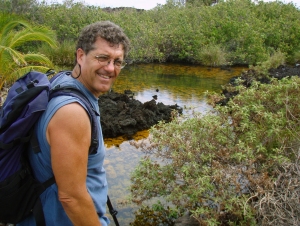
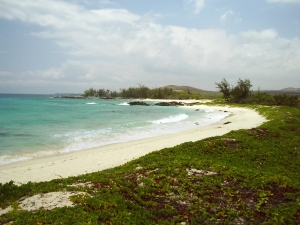
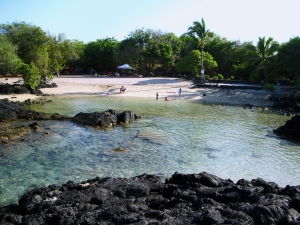
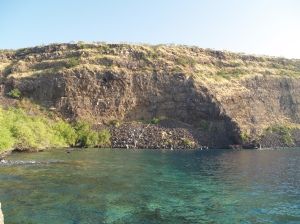

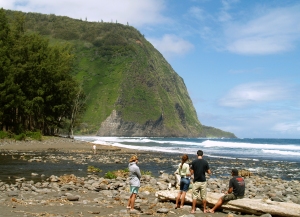

No comments:
Post a Comment